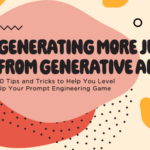Published by
Artificial Intelligence is a noteworthy addition to conversations within and around the technology space. It’s touted as a tool that can increase efficiencies and reduce our mundane tasks.
While there is a great excitement around the advantages of using AI in our daily work, particularly in the field of user research, there remain concerns around properly leveraging the tool: algorithmic bias, data privacy, and losing the crucial human touch.
With the ever-evolving landscape of AI and our iterative integration of AI into our user research practice, at Bottle Rocket, we’re continuously experimenting with leveraging a strong ethical framework. AI isn’t just a tool for efficiency; it’s a catalyst for more ethical, comprehensive, and ultimately, more reliable user insights leading to better product decisions. This isn’t a matter of replacing human researchers but empowering them.
Bottle Rocket approaches artificial intelligence and user research with ethical foundations, intentional plans for inclusive insights, and strategic efficiencies.
Starting with Ethical Tools
AI-powered tools are becoming more prevalent, yet not all are created equal. Our team vets each vendor and tool prior to obtaining licenses to ensure their AI models and features align with our values of security, transparency, and trustworthiness, thereby minimizing legal and reputational risks for our clients and ensure the integrity of the data we collect.
Two prominent tools in our user research toolkit are industry-leading UserTesting.com and enterprise-level WPP Open. They are built on robust data governance and privacy features (like GDPR/CCPA compliance, anonymization capabilities) and can help flag potential PII or sensitive data. Furthermore, these tools ensure consent forms and communications with participants are clear and written in simple terms for transparency and understanding. Crucially, these tools are grounded in evidence-based insight generation, ensuring insights derive from real user data, not AI-generated fabrications.
Reducing Bias and Increasing Inclusive Insights
AI plays a crucial role in refining our research approach, particularly during the planning stages, by helping us incorporate broader viewpoints and actively reduce inherent bias. A key way we leverage AI is by prompting it with questions like, ‘What perspectives might we be missing?’ or ‘Are there any angles we haven’t considered?’ This helps us uncover blind spots and broaden our initial scope.
This process allows us to refine our key questions and goals, optimize recruitment screeners, and enhance interview scripts, all to ensure we include the right people and ask the right things. The goal is to generate insights that are truly actionable and informative for product decisions. Here’s how AI helps us achieve this:
- Bias Detection: AI can analyze proposed screener questions and interview scripts, flagging language that might be leading, culturally insensitive, or inadvertently exclude specific demographics.
- Inclusive Recruitment: AI also plays a vital role in ensuring diverse participant representation. It can help us identify and include underrepresented demographic groups, leading to a more accurate and inclusive understanding of our target audiences.
- Holistic Understanding: Additionally, AI can suggest adjacent topics or uncover new user pain points, providing a more comprehensive understanding of what to explore in a research project.
These proactive bias reductions lead to more robust data and ultimately prevent costly product missteps.
Strategic Efficiencies to Maximize Impact and Minimize Cost
Time is money, and, as mentioned, AI significantly trims down the initial setup phase of a research project allowing for a much quicker study launch. By leveraging large language models, we can rapidly generate tailored ideas for project goals by synthesizing insights from client discussions, discovery workshops, and secondary research artifacts, draft initial screener questions, and even outline interview scripts, all aligned with your specific product objectives. This efficiency extends to the data synthesis stage.AI can help identify recurring themes, perform sentiment analysis on open-ended feedback, and even draft initial summaries of findings. This doesn’t replace human insight, but it frees our researchers from tedious manual tasks, allowing them to dedicate more time to nuanced interpretation, cross-referencing data, and crafting truly actionable recommendations. The result? Projects get up and running faster, insights are delivered more quickly, and your product teams can make informed decisions with unprecedented agility. This directly contributes to decreasing your time-to-launch and optimizing your product development budget.
Ultimately, AI isn’t just a tool for automation; it’s a partner in building a more ethical, inclusive, and efficient user research practice. For product owners, this means more reliable insights, faster decision-making, and ultimately, better products for your users. Let’s explore how these advancements can accelerate your product’s success.




